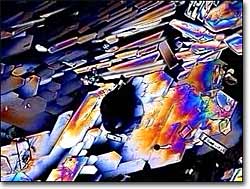Carnitine Movies

Carnitine Video No. 1 - Carnitine dissolution is observed under polarized light illumination at a magnification of 20x in this video. Playing time is 8.7 seconds. Choose a playback format that matches your connection speed: 28.8k (modem), 56.6k (modem), or T1/Cable/DSL, or download this video clip in MPEG format (3.69 MB).
Carnitine Video No. 2 - Carnitine dissolution is observed under polarized light illumination at a magnification of 20x in this video. Playing time is 6.2 seconds. Choose a playback format that matches your connection speed: 28.8k (modem), 56.6k (modem), or T1/Cable/DSL, or download this video clip in MPEG format (1.34 MB).
Carnitine Video No. 3 - Carnitine dissolution is observed under polarized light illumination at a magnification of 20x in this video. Playing time is 11.4 seconds. Choose a playback format that matches your connection speed: 28.8k (modem), 56.6k (modem), or T1/Cable/DSL, or download this video clip in MPEG format (4.89 MB).
Carnitine Video No. 4 - Carnitine dissolution is observed under polarized light illumination at a magnification of 20x in this video. Playing time is 11.4 seconds. Choose a playback format that matches your connection speed: 28.8k (modem), 56.6k (modem), or T1/Cable/DSL, or download this video clip in MPEG format (2.20 MB).
Carnitine Video No. 5 - Carnitine dissolution is observed under polarized light illumination at a magnification of 20x in this video. Playing time is 8.5 seconds. Choose a playback format that matches your connection speed: 28.8k (modem), 56.6k (modem), or T1/Cable/DSL, or download this video clip in MPEG format (3.53 MB).
Discovered in 1905, L-carnitine is a nitrogen-containing, short-chain carboxylic acid. Technically, it is not an amino acid, but a water-soluble, vitamin-like compound that is readily synthesized in the body from the amino acids lysine and methionine and Vitamin C. In mammals, L-Carnitine is produced in liver, kidney and brain tissue and stored in skeletal and cardiac muscle. In the cell, L-carnitine functions in a three-part enzyme complex that is responsible for transporting long-chain fatty acids across the mitochondrial membrane into the interior where they are converted into energy for the cell.
Dietary carnitine comes from sources such as meat, particularly beef, sheep, and lamb. Other animal products, such as milk, cheese, and poultry, contain lesser amounts, while fruits and vegetables have negligible amounts. A diet with sufficient quantities of lysine and methionine will provide the necessary building blocks for the body to synthesize and maintain sufficient levels of carnitine.
